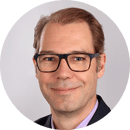Data-Powered Automotive R&D: Empowering Engineers with AI
The automotive industry is becoming increasingly competitive, with a growing focus on developing future mobility solutions. In this landscape, leveraging intelligent innovations for accelerated R&D is crucial for keeping the competitive edge. One promising avenue is the integration of advanced Artificial Intelligence (AI) solutions into the engineering workflow.
Monolith’s approach: Engineers lead the way, catering specifically to engineers and their clients' needs ensuring effective integration of AI into the engineering workflow. By Engineers. For engineers.

“Most AI initiatives start with data scientists and lack the support and inclusion of the test engineers, thus no domain knowledge is included right from the beginning. That poses a major challenge when adopting AI technologies.”
Oliver Walter
Previous Product Manager for the BMW 7-Series / BMW i3 & Digital Program Manager in R&D at BMW
The Status Quo
Only a few companies make the most of their engineering data potential, despite already having spent the money to gather it. On average, only 50% of surveyed engineering leaders use AI to analyse test data of current or upcoming products, and only 29% use it to analyse test data from historic products. Half of all respondents don’t analyse historic data at all.
Figure 1: A commissioned study conducted by Forrester Consulting on behalf of Monolith | May 2023 Source
Engineering leaders are especially missing out when it comes to unsupervised learning algorithms — less than 19% of researchers use this advanced method to analyse their test data. However, unsupervised learning algorithms are particularly crucial when testing products that are hard to model or simulate and involve complex, nonlinear physics. They enable instant analysis of vast amounts of data and help engineers discover unexpected risks and find patterns without defined hypotheses (see Figure 1).
The Potential of AI in Automotive Engineering
AI software offers a wide array of benefits that can unlock faster product development and higher-quality solutions. Engineers themselves can leverage AI tools to expedite time-consuming validation stages and simultaneously train multiple self-learning AI models. These models become more valuable with increased data and proper contextualization by engineers.
Data exploration inside of Monolith. One of the first steps in data preparation, and an easy way for engineers to investigate their large datasets before manipulating them.
A commonly used data format is time series. Applications tackling predictive maintenance vehicle motion, or fuel sloshing noise prediction often fall into this category. A common issue here is the different sample rates of the data collected, but Monolith provides pre-processing tools and capabilities needed to bring these together on a common-time basis.
Challenges in Data Management
Effectively utilising AI software requires identifying the right data and understanding how to apply it in the engineering workflow. Data scientists, who may lack engineering domain expertise, often struggle to target relevant datasets that can be leveraged by AI. This results in unnecessary time and resource investments, since they have to get the engineer's view (context) on it anyway. So why not enable the engineers to apply AI technology at their fingertips?
Firstly, data quality is of paramount importance. AI models rely on accurate and reliable data to produce meaningful insights. However, engineering companies often need help with ensuring the safety and quality of their data. Incomplete, inconsistent, or erroneous data can hinder the effectiveness of AI models, leading to unreliable outcomes and flawed decision-making.
 “The effective leverage of AI solutions will not be achieved by data scientists alone. It always includes the relevant test engineers with their specific domain knowledge.”
“The effective leverage of AI solutions will not be achieved by data scientists alone. It always includes the relevant test engineers with their specific domain knowledge.”
-Oliver Walter
Secondly, data quantity plays a crucial role in training robust AI models. Adequate data volume is essential for AI algorithms to identify patterns, correlations, and trends accurately. Insufficient data can result in underdeveloped models, limiting their ability to provide valuable insights or make accurate predictions.
Thirdly, the context of data is vital for effective AI utilisation. Engineering teams need to understand the engineering, manufacturing and testing context in which the data was generated to properly interpret and leverage it. Without the necessary context, data loses its relevance and potential value, making it challenging to extract meaningful insights or optimise the R&D process.
Additionally, integrating AI technologies with existing workflows and legacy systems presents another challenge. Engineering companies often rely on traditional methods and established processes, making it difficult to seamlessly incorporate AI into their operations. Adapting workflows, ensuring compatibility with legacy systems, and training engineers in AI techniques require careful planning and execution.
Overcoming these data-related challenges requires a comprehensive approach. Engineering companies need to develop and invest in robust data management systems that ensure data integrity, consistency, and accessibility. They should also focus on data acquisition possibilities to gather a sufficient volume of high-quality data relevant to their specific engineering needs.
Engineering companies face major challenges in data availability, understanding, and handling in AI. The visual explores obstacles such as scattered data sources, limited access to external data, inadequate data visualisation tools, and the complexities of data preprocessing, security and privacy, emphasising the need for effective solutions to unleash the power of data-driven decision-making.
Strengthening Data Management Systems
To address this challenge, organisations need to strengthen their data management systems. This involves identifying useful data, determining the relevant engineering context, and equipping product development teams with the tools to efficiently leverage data, context, and AI to create software. By doing so, AI's potential to enhance product development can be fully realised, driving efficiency throughout the engineering workflow and facilitating faster product innovation.
Transition to AI in Engineering Practices
Despite recognizing the potential of AI, only a small percentage of engineering teams currently utilise machine learning for root cause analysis using historical or current test data. Many organisations still rely on physics-based simulation methods or legacy hardware-testing procedures. Even with a data strategy in place, engineers often struggle to identify proper historic data without disrupting existing workflows.
The Importance of Accurate Data and Context
For AI to deliver accurate results, it depends not only on the quantity but also the quality of the data. Manufacturers must invest time and effort in understanding their data, considering the complexity of the problems they aim to solve with AI, and determining the necessary data points throughout the process. AI should be seen as a tool to augment the engineering and testing process, leveraging valuable existing data to ensure accurate and reliable results effectively and in less time.
Unlocking the Potential of AI
AI holds immense potential for helping automotive businesses predict trends, reduce their (prototype) testing efforts and reach meaningful answers to highly complex situations. By empowering engineers to understand their data (and their colleague's upstream/downstream data), apply it effectively in their workflows, and build and feed AI models themselves, organisations can unlock a faster path to innovation and gain a competitive edge. Engineers possess invaluable expertise and contextual knowledge, and AI enables them to extract the true value from their data.
 “The data size and amount of data is not key. However, the data coherence and the interpretation of the results is!”
“The data size and amount of data is not key. However, the data coherence and the interpretation of the results is!”
-Oliver Walter
Artificial Intelligence has the ability to revolutionise automotive R&D and AI research by exploring the right data strategy. By integrating AI software into the engineering workflow, automakers can expedite product development, physical product testing, enhance quality, and stay ahead of the competition. With the right data management systems and a thorough understanding of how to leverage AI effectively, the automotive industry can embrace the full potential of AI and drive innovation to new heights.





